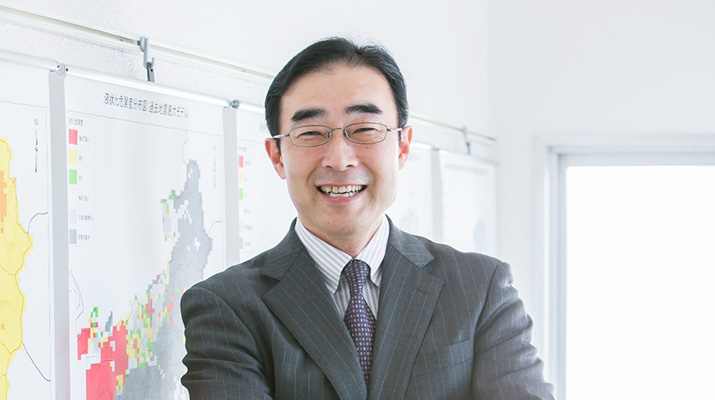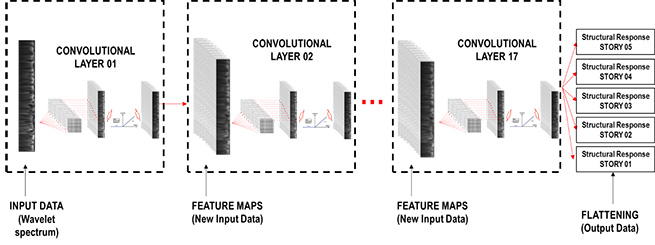
ここからコンテンツです。

Using machine learning to measure building earthquake damage
Facilitating evacuation immediately following an earthquake and the continued use of buildings Taiki Saito
Damage caused to municipal government office buildings by the 2016 Kumamoto Earthquakes significantly hindered the evacuation and reconstruction efforts which followed. We need to develop technology that enables us to inspect municipal government offices, fire departments and other hub buildings for disaster control activities immediately after an earthquake occurs. The Earthquake Disaster Engineering Research Laboratory in the Department of Architecture and Civil Engineering, Toyohashi University of Technology, has developed a method for instantaneously evaluating earthquake damage to a building from the readings of the building’s seismometer using machine learning technology. All city government offices in the Higashi-Mikawa area are already equipped with seismometers and a system for sharing the results of damage assessments by email immediately after an earthquake has been established. Applying the machine learning technology that has been developed will enable faster, more accurate damage assessment.
Municipal government offices, fire departments and other hubs responsible for implementing measures following an earthquake must be capable of assessing damage to their buildings immediately after an earthquake, to determine whether the building is still fit for purpose. To date, the methods for evaluating a building’s condition after an earthquake have basically been limited to visual inspections from outside of the building because of the potential of an aftershock to cause the building to collapse. For this reason, it has been difficult to assess internal building damage after a large earthquake. The research team has developed a method for remotely assessing the condition of a building during an earthquake based on the readings from the building's seismometer. This method uses observation records stored on the Internet-cloud to analyze the response of the structural model of the building and based on these results, assess damage. However, a highly accurate diagnosis required time-consuming analysis. So, the research team developed a method for immediately assessing building damage using machine learning technology without the need for a structural model of the building.

The method would remotely and immediately assess the level of earthquake damage (no damage, mild damage, moderate damage, severe damage, collapse) and whether the damaged building can continue to be used (safe, caution needed, dangerous) . It bases these assessents on images of the wavelet spectra of observed waveforms from seismometers installed in the building using the CNN (Convolutional Neural Network) machine learning method. Edisson Alberto Moscoso Alcantara, the lead author and doctoral student, explains damage assessments using the new method will be faster than the conventional method using a structural model of the building.
"Machine learning technology is rapidly spreading across the field of earthquake preparedness. Previously, assessing damage to a building was dependent on human experience. In the future, this will be automatically handled by AI. The goal of the research is to establish a method for remotely assessing the condition of a building right after an earthquake without having to send someone to the site. Initially, we were concerned about whether it would be possible to determine the extent of damage using only the waveform of the seismometer, but we found that we could determine the extent of damage with considerable accuracy by using wavelet spectra," says Professor Taiki Saito, the leader of the research team.
The method for assessing earthquake damage developed by the research team may be applicable irrespective of the differences in buildings, such as the number of floors or the structure of the building. A real-time seismic testing system developed by Toyohashi University of Technology is already being used in city government office buildings in the Higashi-Mikawa area. Hopefully, the new method will allow for a faster and more accurate seismic diagnosis, thereby contributing to the improvement of disaster preparedness in the region.
Reference
Edisson Alberto Moscoso Alcantara, Michelle Diana Bong and Taiki Saito (2021). Structural Response Prediction for Damage Identification using Wavelet Spectra in Convolutional Neural Network. Sensors 2021, 21(20), 6795;
https://doi.org/10.3390/s21206795
機械学習で建物の地震被害を判定する
地震直後の避難や建物の継続使用に役立てる齋藤 大樹
2016年の熊本地震では、複数の市役所が被災し、避難や復旧の大きな障害になりました。地震直後に市役所や消防署などの防災拠点建物の健全性をいち早く診断する技術の開発が求められています。豊橋技術科学大学建築・都市システム学系の地震災害工学研究室では、建物に設置した地震計の記録から、機械学習の技術を用いて、建物の被害状況を即時に判定する手法を開発しました。すでに、東三河地域のすべての市庁舎に地震計を設置して、地震直後に判定結果をメイル配信するシステムを構築しています。今後は、開発した機械学習技術を応用することで、より迅速で精度の高い被害判定が可能となります。
地震防災の拠点となる市役所や消防署などでは、地震直後に建物の被害状況を分析し、継続して使用できるかを迅速に判断する必要があります。これまでは、余震による建物倒壊の危険があるため、診断は原則として目視による外観調査に限られており、建物内部の被害状況は分かりませんでした。そのため、研究チームでは、建物に地震計を設置して、地震時の観測記録から建物の健全性評価を遠隔で行う技術を開発してきました。この方法では、インターネット・クラウドに保存された観測記録を用いて、建物の構造モデルの地震応答解析を行い、その結果から被害程度を診断します。しかし、精度の高い診断のためには、時間のかかる解析が必要でした。
そこで、建物の構造モデルを使わずに、機械学習の技術を用いて、建物の被害状況を即時に判定する手法を開発しました。
この方法では、CNN(Convolutional Neural Network)という機械学習の方法を用いて、建物に設置された地震計の観測波形のウェーブレットスペクトルの画像から、被害の程度(無被害、軽微な被害、中被害、大被害、倒壊)や継続使用の可能性(安全、注意、危険)を遠隔で直ちに診断するものです。これまでの構造モデルを用いた診断よりも、迅速な診断が可能になると、筆頭著者である博士後期課程のEdisson Alberto Moscoso Alcantaraは説明します。
研究チームのリーダーである齊藤大樹教授は、「機械学習の技術は、地震防災の分野でも急速に普及が進んでいます。これまで人間の経験に頼ってきた建物の被害判定も、これからはAIが自動的に行うようになると思われます。この研究は、地震直後に、人が現地に行かなくても遠隔で建物の健全性を診断できる手法の確立を目指したものです。当初は、地震計の波形だけで被害程度が判定できるのか心配でしたが、ウェーブレットスペクトルを用いることで、かなりの精度で判定できることがわかりました。」
研究チームは、開発した地震被害の判定法は、建物の階数や構造が異なる場合でも適用可能であると考えています。すでに、東三河地域の市庁舎には、本学が開発したリアルタイム耐震診断システムが稼働中ですが、本手法を適用することで、より迅速かつ精度の高い診断を可能とし、地域の防災力の向上に役立てていきたいとも考えています。
Researcher Profile

| Name | Taiki Saito |
|---|---|
| Affiliation | Department of Architecture and Civil Engineering |
| Title | Professor |
| Fields of Research | Structural Engineering / Earthquake Engineering |
ここでコンテンツ終わりです。
